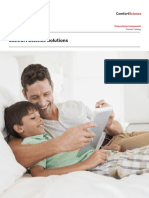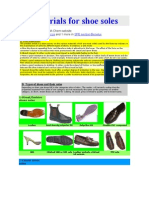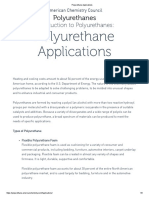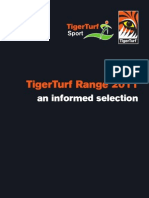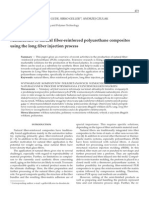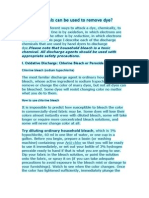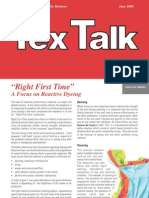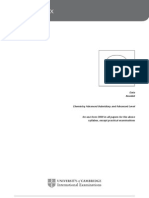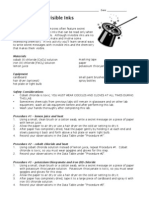Easy Way Foam or Fiber White Paper-1
Easy Way Foam or Fiber White Paper-1
Uploaded by
TomGaliciaCopyright:
Available Formats
Easy Way Foam or Fiber White Paper-1
Easy Way Foam or Fiber White Paper-1
Uploaded by
TomGaliciaOriginal Title
Copyright
Available Formats
Share this document
Did you find this document useful?
Is this content inappropriate?
Copyright:
Available Formats
Easy Way Foam or Fiber White Paper-1
Easy Way Foam or Fiber White Paper-1
Uploaded by
TomGaliciaCopyright:
Available Formats
FOAM OR FIBER?
A Comparison of Fill Material
for Outdoor Cushioning
INTRODUCTION
For the average consumer and retail furniture buyer, navigating the world of cushion materials can be a
confusing proposition. With a technical community that continues to innovate, it is sometimes difficult to
differentiate which innovations create real value in terms of performance and customer experience and
which are just enhanced marketing. Polyurethane foam and polyester fiber remain the industry stand-
ards, yet the variety of choices that exist within these two options create a decision-making process that
is significantly more complex.
KEY PARAMETERS IN CHOOSING POLYURETHANE FOAM 1,2,3
Polyurethane foam has long been a staple of the cushion industry. Its excellent performance over
extended use coupled with a variety of types that can be tailored to specific applications allow retailers
to customize their offerings to individual markets.
When discussing the material in terms of outdoor performance, there are a few characteristics that
require some consideration. All flexible polyurethane foams have an open cellular structure which,
when applied in an outdoor setting, means that moisture can penetrate the body of the foam. While
polyurethane foam itself has antimicrobial properties, additional additives are often preferred for use
in outdoor applications in order to further protect against the effects of exposure to moisture. The other
two main performance elements to consider when reviewing foam are density and indentation force
deflection (IFD). Density, typically measured in pounds per cubic foot or kilograms per cubic meter, is
one of the key determining characteristics of a foam’s durability. A higher density rating will in most
cases equate to longer-term durability in the finished product. IFD refers essentially to the feel of finished
foam—i.e., the hardness or softness thereof. IFD is measured by the pounds of force required to indent
a piece of foam to 25% of its original thickness. Standard ranges are from five pounds (softest) to eighty
pounds (hardest).
Taking into account projected use and required longevity in the market, these criteria are key in
determining the appropriate foam type for a specific application.
8950 Rossash Road, Cincinnati, OH 45236 | (513) 731-5640 | easywayproducts.com | 1
COMMON FOAM TYPES2
Standard foam
This is the most common type of polyurethane foam available. It is able to be
poured with a variety of densities and IFDs, making it a viable option for myriad
applications, both indoor and outdoor. In standard cushion applications, it can
provide the comfort, support and durability required.
High resiliency polyurethane foam
This foam type is almost identical to the standard foam in use and function, with
one key exception. It is created by using a higher grade of raw material and a
slightly altered process that makes the cellular structure of the finished foam more
random than that of standard foam. This has two distinct effects: first, this foam will
return to its original shape more quickly than a standard foam when compressed.
The second and perhaps more important effect is that this altered cellular structure
gives the foam a higher durability than its standard counterpart. This foam has a
clear use in high traffic situations where performance is required over an extended
or heightened period of use.
Dry fast or “reticulated” foam
This foam type is standard open cell foam which has had the cellular structure
exploded in order to create an open porosity visible to the naked eye. While other
foams in this category may retain moisture, the structure of reticulated foam has
been opened to an extent that it will pass directly through. The challenge with this
material is that, due to the volatility of the process used to make it, there is only a
limited offering in both density and feel (IFD). This foam is primarily used for outdoor
applications in the cushion industry as well as in the filtration industry.
Viscoelastic memory foam
This foam is also occasionally dubbed “slow recovery” foam. The key characteristic
of viscoelastic foam is that the cellular structure is more fluid, conforming to pressure
and returning to original form at a slower rate than standard foams. This makes it
ideal for use as a comfort layer in mattresses and other typically indoor furnishings. It
does, however, have a couple of challenges due to its structure: it is less supportive
than standard foams, and it is highly sensitive to heat and humidity (both of which
affect the recovery of the material and can limit its outdoor uses).4
New foam trends and technical developments: As mentioned earlier, the technical side of the foam
industry is ever evolving, which is giving the market access to new products all the time. A few of the most
exciting new developments are cool touch foams, mineral-infused foams and eco foam. Cool touch
foams are being heavily used in the mattress industry, as they have a less reactive structure to heat (both
in dispersion and the way heat influences the structural integrity of the material). Mineral infused foams
can give a foam mattress a lavender scent over an extended term of use (again, marketed toward
the mattress industry). Eco foams use plant-based chemicals as a portion of the raw material (versus
complete use of petroleum-based chemicals) for a more environmentally friendly, sustainable product.
While these are currently used predominantly in the indoor cushion and mattress industries, as the
technology continues to evolve so too will the range of uses.5
8950 Rossash Road, Cincinnati, OH 45236 | (513) 731-5640 | easywayproducts.com | 2
KEY PARAMETERS IN CHOOSING POLYESTER FIBER 6,7
Polyester fiber has long competed with foam as the fill material of choice in the cushion industry—
particularly when it comes to outdoor applications. Not only is it typically cheaper than the foam
alternative, but its natural properties make it antimicrobial and moisture resistant.
When discussing fiber characteristics for any application, there are four traits that affect performance:
1. Denier, which equates to the thickness of the fiber. A thinner denier will have a softer feel,
whereas a thicker denier will have a coarser, robust feel.
2. Length of the fiber, which affects how the fiber fills out the covering and how much fiber is
required to meet the finish.
3. Crimp of the fiber, which speaks to the number of bends put into each strand of material.
The crimp is particularly relevant in blown applications where more highly-crimped fibers have
a higher resilience.
4. Conjugation of the fiber, or twist, which adds to the fiber’s resilience.
Additionally, fibers come in several classifications dependent on the base material—for example, virgin,
semi-virgin or recycled, which speak to the amount of recycled material included in the finished fiber.
Many recycled materials can come close to the performance of the virgin (new) material; however,
virgin material will have the overall best durability and feel.
COMMON POLYESTER FIBER FINISHES 6,7
Blown polyester
Often, raw polyester fibers are mixed and blown into casings as a fill material for
pillows. This is a common alternative to down pillows or shredded polyurethane
foam. Additionally, some of the more expensive low-denier virgin materials
(down alternative) can very closely imitate the feel and function of down while
maintaining the properties that make it ideal for outdoor use. While this virgin
material is somewhat more costly than the recycled options in the market, a
wide variety of feels and finishes can be provided by each for use as pillows
or cushioning.
Thermal bonded batted polyester
Thermal bonded batted polyester consists of polyester fibers which go through
a mixing, layering and heat treating process to create a substitute product for
polyurethane foam. This material can be layered to a variety of densities and
thicknesses to emulate the properties of foam. While this material is cheaper than
foam options and does not retain moisture as many of the foam options can, it
suffers from a lower durability than comparable foam options. This is an important
consideration when weighing it against foam as a fill material for cushions,
dependent on the expected life cycle of the finished good.
8950 Rossash Road, Cincinnati, OH 45236 | (513) 731-5640 | easywayproducts.com | 3
COMPARISON BETWEEN FOAM AND FIBER USE
When finally comparing polyurethane foam versus polyester fiber applications, particularly for outdoor
use, note that it is possible to create a high-performing and durable product using either. The key is
matching the performance expectation, environmental expectations and required finished feel and
aesthetic with the appropriate material.
FILL MATERIAL DECISION MATRIX
Moisture Microbial Market
Durability Cost Notes
Resistance Resistance Applications
Standard Furniture Widely used industry
Polyurethane Good Good Better Mid cushioning, standard for cushioning
Foam Insulation and upholstery
High
Furniture Used widely in contract
Resilience
Good Good Best Mid-High cushioning, and commercial
Polyurethane
Insulation furniture applications
Foam
For cushioning, used
Dry Fast or Furniture primarily in outdoor
Reticulated Best Best Better High cushioning, applications due to
Foam Filtration moisture resistance
and weathering
Widely used in the
Primarily
bedding industry;
Viscoelastic indoor
limited outdoor
Memory Good Good Good High furniture
applications due
Foam cushioning,
to temp and
Mattresses
humidity sensitivity
Current main uses are
Specialty Primarily
Variable Variable Variable High in the indoor furnishing
Foams mattresses
and bedding industries
Blown Great alternative
Polyester Better Better Good Low-Mid Pillows to down as a
Fiber pillow material
Lower cost alternative
Batted Furniture to foam for
Polyester Better Better Good Low cushioning, cushion seating
Fiber Insulation and items requiring
added support
8950 Rossash Road, Cincinnati, OH 45236 | (513) 731-5640 | easywayproducts.com | 4
CONCLUSION
The number of options for cushion fill material can be daunting. Understanding the market, environment
and customer expectations is critical to wading through the plethora of options available. With our
experience in the development and fabrication of multiple fill programs, Easy Way Products can work
with you to select the ideal fill material for your application. This service, in conjunction with our robust
supply chain, allows our customers to bring a variety of high performance outdoor furnishing options to
the retail consumer.
REFERENCES
1. American Chemistry Council “Polyurethanes”, January 19th , 2016 http://polyurethane.
americanchemistry.com/Introduction-to-Polyurethanes
2. Polyurethane Foam Association (PFA), January 19th , 2016 http://www.pfa.org
3. Joint Industry Foam Standards and Guidelines: “Indentation and Force Deflection (IFD) Standards
and Guidelines”, July 1994 http://www.pfa.org/jifsg/jifsgs4.html
4. “The effects of moisture absorption on the physical properties of polyurethane shape memory
polymer foams”, August 1st , 2011 http://www.ncbi.nlm.nih.gov/pmc/articles/PMC3176498/
5. Foam Partner, January 19th, 2016 http://www.foampartner.com/en/
6. Stein Fiber, January 19th , 2016 http://www.steinfibers.com/
7. Textile Learner Blog “Polyester Fiber” January 19th , 2016 http://textilelearner.blogspot.
com/2011/07/polyester-fiber-characteristics-of_11.html
Easy Way Products is the premier provider of lifestyle furnishings for the retail market. From cushions
and pillows to table runners and drapes, we work with you to create unique and beautiful designs to
complement your outdoor furniture lines.
For more information about our fill programs and other manufacturing capabilities, give us a call
at (513) 731-5640.
8950 Rossash Road, Cincinnati, OH 45236 | (513) 731-5640 | easywayproducts.com | 5
You might also like
- Production of High Quality FoamDocument73 pagesProduction of High Quality FoamMOHAMMED YUSUF MAIAGOGO100% (1)
- Dow - Comfort Science SolutionsDocument8 pagesDow - Comfort Science SolutionsLilia de MendozaNo ratings yet
- How Importance of Cell Structure For Viscoelastic Foams PolyuretgabDocument13 pagesHow Importance of Cell Structure For Viscoelastic Foams PolyuretgabajoilhamNo ratings yet
- Materials For Shoe SolesDocument6 pagesMaterials For Shoe SolesLawrence Theunissen100% (1)
- Icf & Rdso Vendor ListDocument206 pagesIcf & Rdso Vendor ListVipul PanchalNo ratings yet
- LR IntouchV1.1Document8 pagesLR IntouchV1.1Mahmood Anwar ShadNo ratings yet
- Flexible Polyurethane Foam A PrimerDocument7 pagesFlexible Polyurethane Foam A PrimerirwanchemNo ratings yet
- About Memory Foam by Flexible Pu Acco PDFDocument7 pagesAbout Memory Foam by Flexible Pu Acco PDFSunny PatelNo ratings yet
- Presentation For Different Innovative Applications For Polyester Thermo Bonded ProductsDocument31 pagesPresentation For Different Innovative Applications For Polyester Thermo Bonded ProductsravibaroraNo ratings yet
- Polyurethane Foam ThesisDocument6 pagesPolyurethane Foam ThesisHowToWriteMyPaperOmaha100% (2)
- Research and Application of Visco-Elastic Memory FDocument5 pagesResearch and Application of Visco-Elastic Memory FTaha AbdouNo ratings yet
- How Foam Firmness AffectsDocument5 pagesHow Foam Firmness AffectsirwanchemNo ratings yet
- POLYESTERDocument5 pagesPOLYESTERAhmed AlbayatiNo ratings yet
- PolyurethaneDocument3 pagesPolyurethaneprincessfelipe20No ratings yet
- Packaging India April May 2018Document5 pagesPackaging India April May 2018Raghuveer SinghNo ratings yet
- ProcessDocument4 pagesProcessYeni Agustiningsih100% (1)
- Natural Rubber Is A Coherent Elastic 9 Id Obtained From A Milky Liquid Known As LatexDocument4 pagesNatural Rubber Is A Coherent Elastic 9 Id Obtained From A Milky Liquid Known As Latexmuhammad jamshed100% (1)
- Recycling 2000Document13 pagesRecycling 2000A MahmoodNo ratings yet
- Preparation and Properties of Split Microfiber Synthetic LeatherDocument3 pagesPreparation and Properties of Split Microfiber Synthetic LeatheraditiNo ratings yet
- HR Foam FunctionDocument8 pagesHR Foam FunctionJina S. Beer100% (1)
- Foam Types TermpaperDocument6 pagesFoam Types TermpaperRolaxNo ratings yet
- Polyisocyanurate vs. Polyurethane InsulationDocument2 pagesPolyisocyanurate vs. Polyurethane Insulationhamza awanNo ratings yet
- PU Foam ManafacturingDocument2 pagesPU Foam ManafacturingMalak HindiNo ratings yet
- Airlaid & Spunlace NonwovenDocument5 pagesAirlaid & Spunlace NonwovenRonak JoshiNo ratings yet
- Polyurethane ApplicationsDocument6 pagesPolyurethane ApplicationsGabriel DiazNo ratings yet
- 2 Bjo-0840Document3 pages2 Bjo-0840chayanunNo ratings yet
- Most Disposable Diapers Are Made With The Following Basic ComponentsDocument4 pagesMost Disposable Diapers Are Made With The Following Basic ComponentsIvyNo ratings yet
- foam rubberDocument5 pagesfoam rubberVeerasubramanian DoraisamyNo ratings yet
- ISOPA-FACTSHEET Recycling and RecoveryPolyurethanes V02Document2 pagesISOPA-FACTSHEET Recycling and RecoveryPolyurethanes V02irwanchemNo ratings yet
- Foam vs. Memory Foam Beds Is One Type BetterDocument1 pageFoam vs. Memory Foam Beds Is One Type BetterAnnissa RNo ratings yet
- Thesis Natural RubberDocument4 pagesThesis Natural Rubberafkololop100% (2)
- The Preparation and Performance Study of MDI-Based Water-Blown Flexible Polyurethane FoamDocument7 pagesThe Preparation and Performance Study of MDI-Based Water-Blown Flexible Polyurethane Foamolabanji ogunleyeNo ratings yet
- Manufacturing ProcessDocument4 pagesManufacturing ProcessRana Afrasyab SaeedNo ratings yet
- Sanyo Chemical Product Outline: ProductlistDocument4 pagesSanyo Chemical Product Outline: ProductlistA MahmoodNo ratings yet
- Film Sheet PresentationDocument24 pagesFilm Sheet PresentationNemo Cyzar Liis100% (1)
- Plastic MaterialsDocument8 pagesPlastic MaterialsHailu BeyechaNo ratings yet
- Thermal Insulation MaterialsDocument33 pagesThermal Insulation MaterialsVishal Gupta100% (1)
- TigerTurf Sports Product Brochure 2011Document24 pagesTigerTurf Sports Product Brochure 2011safinditNo ratings yet
- Worldwide Consumption of Thermoplastic Polyurethane ElastomersDocument5 pagesWorldwide Consumption of Thermoplastic Polyurethane ElastomersHerat TrivediNo ratings yet
- Bagging FilmsDocument10 pagesBagging FilmsArslan AhmedNo ratings yet
- Nonwoven Fabric - Wikipedia, The Free EncyclopediaDocument5 pagesNonwoven Fabric - Wikipedia, The Free EncyclopediasangareeeNo ratings yet
- ReportDocument7 pagesReportSonika AgarwalNo ratings yet
- Product ListDocument3 pagesProduct ListA MahmoodNo ratings yet
- Rigid Foam (R-3.8 To R-8.7 Per In.)Document4 pagesRigid Foam (R-3.8 To R-8.7 Per In.)Raine ReyesNo ratings yet
- Vestolit BR Textile-Coatings Web EN 2022-10Document12 pagesVestolit BR Textile-Coatings Web EN 2022-10Betty GonzálezNo ratings yet
- Packaging FilmsDocument47 pagesPackaging Filmsnitin100% (1)
- Hemp-Flax 2Document4 pagesHemp-Flax 2Gerson -No ratings yet
- Foam FabricationDocument4 pagesFoam FabricationirwanchemNo ratings yet
- Assignment 2 (Archit Todi 17 - 274)Document15 pagesAssignment 2 (Archit Todi 17 - 274)chemical todiNo ratings yet
- 02 Bio CompositeDocument8 pages02 Bio CompositeMD Sunjin AhsunNo ratings yet
- PolyurethaneDocument17 pagesPolyurethaneMas AtmaNo ratings yet
- Manufacture of Natural Fiber-Reinforced Polyurethane Composites Using The Long Fiber Injection ProcessDocument3 pagesManufacture of Natural Fiber-Reinforced Polyurethane Composites Using The Long Fiber Injection ProcessAshokan KelothNo ratings yet
- Some Polymers Its ApplicationsDocument41 pagesSome Polymers Its ApplicationsManoranjan PandaNo ratings yet
- Choose The Right RollerDocument7 pagesChoose The Right Rollerkartik spectomsNo ratings yet
- Polyethylene Product PDFDocument16 pagesPolyethylene Product PDFpolymeianNo ratings yet
- Advanced Packaging Technologies For Fruits and Vegetables: For Fruits and VegetablesFrom EverandAdvanced Packaging Technologies For Fruits and Vegetables: For Fruits and VegetablesNo ratings yet
- Dupont™ Crastin S600F40 Nc010: Thermoplastic Polyester ResinDocument11 pagesDupont™ Crastin S600F40 Nc010: Thermoplastic Polyester ResinTomGaliciaNo ratings yet
- PR-OMF Staple Force S 1000 Bico enDocument2 pagesPR-OMF Staple Force S 1000 Bico enTomGaliciaNo ratings yet
- Polylactic Acid Polyols in Urethane Coatings - 2019-11-01 - PCI MagazineDocument17 pagesPolylactic Acid Polyols in Urethane Coatings - 2019-11-01 - PCI MagazineTomGaliciaNo ratings yet
- Thickener FLOGEL 700 EDocument4 pagesThickener FLOGEL 700 ETomGaliciaNo ratings yet
- Stylebook Vs Closet+Document15 pagesStylebook Vs Closet+TomGaliciaNo ratings yet
- Guo2018 PDFDocument6 pagesGuo2018 PDFTomGaliciaNo ratings yet
- Perkalite® F100 - AkzoNobelDocument2 pagesPerkalite® F100 - AkzoNobelTomGaliciaNo ratings yet
- A Novel Catalyst For The Glycolysis of Polyethylene TerephthalateDocument5 pagesA Novel Catalyst For The Glycolysis of Polyethylene TerephthalateTomGaliciaNo ratings yet
- A Novel Catalyst For The Glycolysis of Polyethylene TerephthalateDocument5 pagesA Novel Catalyst For The Glycolysis of Polyethylene TerephthalateTomGaliciaNo ratings yet
- Perkalite® F100 - AkzoNobelDocument2 pagesPerkalite® F100 - AkzoNobelTomGaliciaNo ratings yet
- SporActiv Full Catalog Sheet - 003Document2 pagesSporActiv Full Catalog Sheet - 003TomGaliciaNo ratings yet
- What Is A Moso Natural Air Purifying BagDocument2 pagesWhat Is A Moso Natural Air Purifying BagTomGaliciaNo ratings yet
- Guo2018 PDFDocument6 pagesGuo2018 PDFTomGaliciaNo ratings yet
- Plastic Has A Problem Is Chemical Recycling The SolutionDocument12 pagesPlastic Has A Problem Is Chemical Recycling The SolutionTomGaliciaNo ratings yet
- Enzyme English 2011 SmallDocument24 pagesEnzyme English 2011 SmallTomGaliciaNo ratings yet
- Recycled Polyamides, A Literature Review and Research OpportunitiesDocument15 pagesRecycled Polyamides, A Literature Review and Research OpportunitiesTomGaliciaNo ratings yet
- Crastin S600 F40 NC010Document11 pagesCrastin S600 F40 NC010TomGaliciaNo ratings yet
- Green Cleaning - Understanding Bio-Enzymatic CleanersDocument3 pagesGreen Cleaning - Understanding Bio-Enzymatic CleanersTomGaliciaNo ratings yet
- Report: PET Glycolysis: ARVI Theme Plastic and Rubber Subtask 4.1.1Document12 pagesReport: PET Glycolysis: ARVI Theme Plastic and Rubber Subtask 4.1.1TomGaliciaNo ratings yet
- Perkalite® F100 - AkzoNobelDocument2 pagesPerkalite® F100 - AkzoNobelTomGaliciaNo ratings yet
- Superclean RecyclingDocument7 pagesSuperclean RecyclingTomGaliciaNo ratings yet
- Waste Plastic Extruder: Literature Review: See AlsoDocument24 pagesWaste Plastic Extruder: Literature Review: See AlsoTomGaliciaNo ratings yet
- Technical Details: Vee Pack SetsDocument4 pagesTechnical Details: Vee Pack SetsJosé HurtadoNo ratings yet
- BMSSA BARC S6 BCM Tensile StructuresDocument21 pagesBMSSA BARC S6 BCM Tensile StructuresRahul J JainNo ratings yet
- Sheet Metal Gauge Size ChartDocument2 pagesSheet Metal Gauge Size ChartRAJENDRANJD20097864No ratings yet
- Professional Laundry Ebook 2 Parts 5 To 8Document26 pagesProfessional Laundry Ebook 2 Parts 5 To 8Edi pebrianNo ratings yet
- New Microsoft Word DocumentDocument29 pagesNew Microsoft Word DocumentWasi HaiderNo ratings yet
- Compounded FormulaDocument14 pagesCompounded FormulaPerm Perm50% (2)
- CBSE Class 12 Biology - Molecular Basis of Inheritance AssignmentDocument13 pagesCBSE Class 12 Biology - Molecular Basis of Inheritance AssignmentVaibhav ChauhanNo ratings yet
- Bracker Short Staple SpinningDocument53 pagesBracker Short Staple SpinningRamesh IyerNo ratings yet
- BLG143 - Final Exam Cheat SheetDocument2 pagesBLG143 - Final Exam Cheat SheetIndraragini AnpalakanNo ratings yet
- BP505T PJ Unit - IiDocument27 pagesBP505T PJ Unit - IiVijiNo ratings yet
- Thermal and Adhesive Bonding of Non-WovensDocument31 pagesThermal and Adhesive Bonding of Non-WovensAyesha Shaikh100% (1)
- Know Your SoapDocument3 pagesKnow Your Soaptagoor varmaNo ratings yet
- Thermoplastics Selection GuideDocument1 pageThermoplastics Selection GuidelokomundoNo ratings yet
- Building Blocks of Hair Care ProductsDocument49 pagesBuilding Blocks of Hair Care Productsjpscop24No ratings yet
- Handbook of Petrochemical Processes: James G. SpeightDocument179 pagesHandbook of Petrochemical Processes: James G. SpeightEmad Ali100% (1)
- "Right First Time": A Focus On Reactive DyeingDocument6 pages"Right First Time": A Focus On Reactive DyeingHafeez UR RehmanNo ratings yet
- Curing Concrete Literature ReviewDocument7 pagesCuring Concrete Literature Reviewn1dihagavun2100% (2)
- PYQ Polymer ScienceDocument2 pagesPYQ Polymer ScienceAnubhav MauryaNo ratings yet
- The Ultimate A-Level Aqa Biology Cheatsheet PackDocument17 pagesThe Ultimate A-Level Aqa Biology Cheatsheet PackJamesNo ratings yet
- State-of-the-Art Report On Fiber Reinforced Plastic (FRP) Reinforcement For Concrete StructuresDocument65 pagesState-of-the-Art Report On Fiber Reinforced Plastic (FRP) Reinforcement For Concrete StructuresDIDIER ANGEL LOPEZ RINCONNo ratings yet
- TUGAS 3 (Classification)Document2 pagesTUGAS 3 (Classification)raden bayu100% (1)
- Appendix: Data BookletDocument13 pagesAppendix: Data BookletAbdullah Nazir100% (1)
- Lab 8Document26 pagesLab 8zero contentNo ratings yet
- Fresh Tomato Aroma Volatiles: A Quantitative Study PDFDocument5 pagesFresh Tomato Aroma Volatiles: A Quantitative Study PDFDaniel Saenz DominguezNo ratings yet
- Share HOW TO FORMULAT-WPS OfficeDocument15 pagesShare HOW TO FORMULAT-WPS OfficeMoosub KhanNo ratings yet
- H.MORETTO-Silicones, Ullmanns Encycopledia of Industriall ChemistryDocument38 pagesH.MORETTO-Silicones, Ullmanns Encycopledia of Industriall ChemistryAldo Córdoba GuerreroNo ratings yet
- Supersci-Chemistry of Invisible InksDocument2 pagesSupersci-Chemistry of Invisible InksHasanzubyreNo ratings yet
- The Identification of Turquoise by Infrared Spectroscopy and X Ray Powder DiffractionDocument5 pagesThe Identification of Turquoise by Infrared Spectroscopy and X Ray Powder Diffraction8duke8No ratings yet
- Multi Tool Outil Multi-Fonctions Multitool: Instruction Manual Manuel D'Instruction Manual de InstruccionesDocument28 pagesMulti Tool Outil Multi-Fonctions Multitool: Instruction Manual Manuel D'Instruction Manual de InstruccionesmarioNo ratings yet

